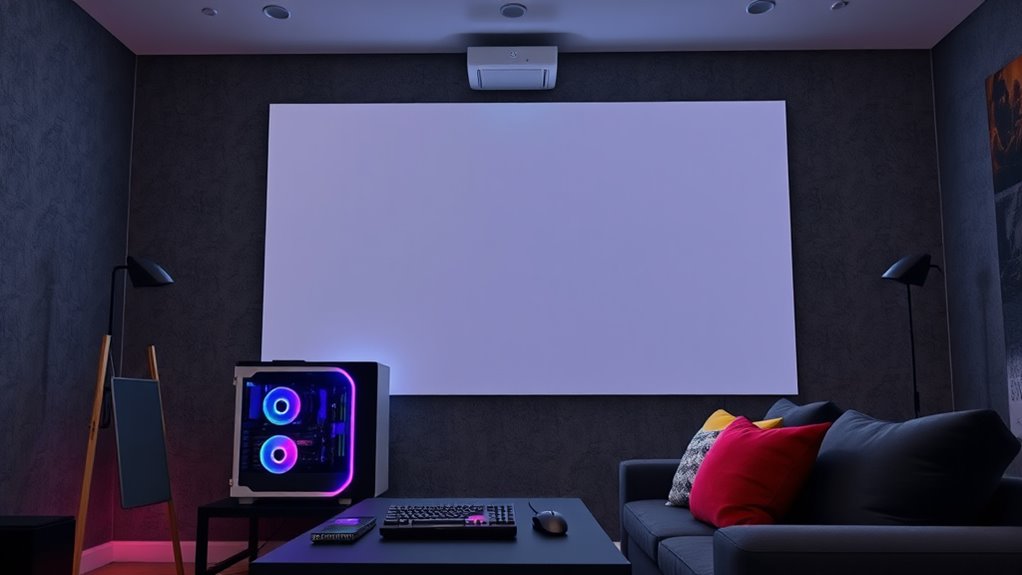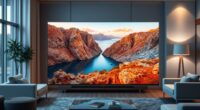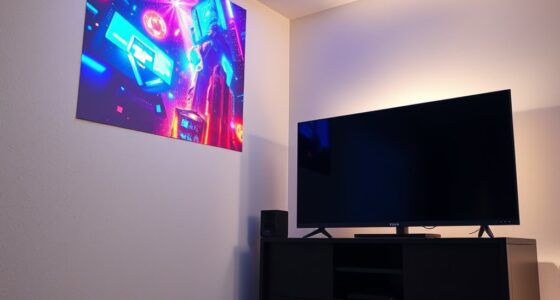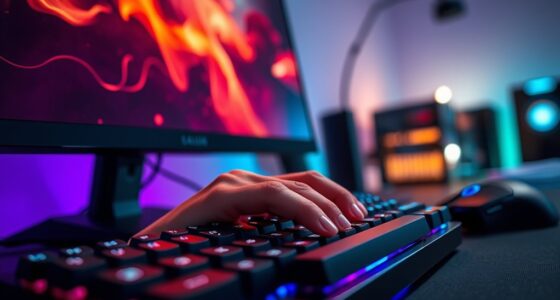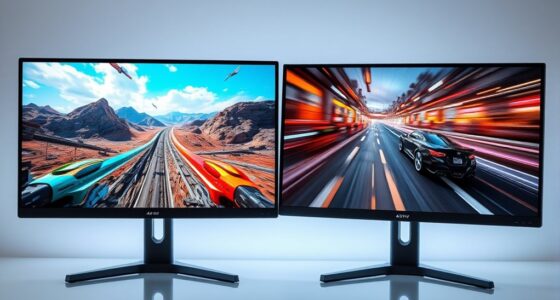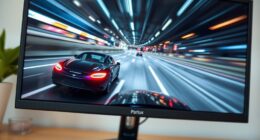For the best PC gaming on a projector, start by calibrating your image settings—adjust contrast, brightness, and color temperature for vibrant visuals. Position external speakers or a soundbar to enhance audio and create an immersive experience. Match your game resolution to the projector’s native resolution and lower graphics settings if needed to improve performance. Use a dark room environment to maximize contrast. If you keep fine-tuning these aspects, you’ll activate ideal visuals and sound—the perfect gaming setup awaits.
Key Takeaways
- Calibrate projector settings for optimal contrast, color accuracy, and keystone correction to ensure clear, vibrant images.
- Use external speakers and position them strategically for immersive, high-quality audio during gameplay.
- Match game resolution to the projector’s native resolution and update graphics drivers for sharp visuals and smooth performance.
- Minimize ambient light by creating a dark environment to enhance contrast, color vibrancy, and overall image clarity.
- Fine-tune PC and game graphics settings to balance performance and visual quality, reducing lag and ensuring a seamless gaming experience.
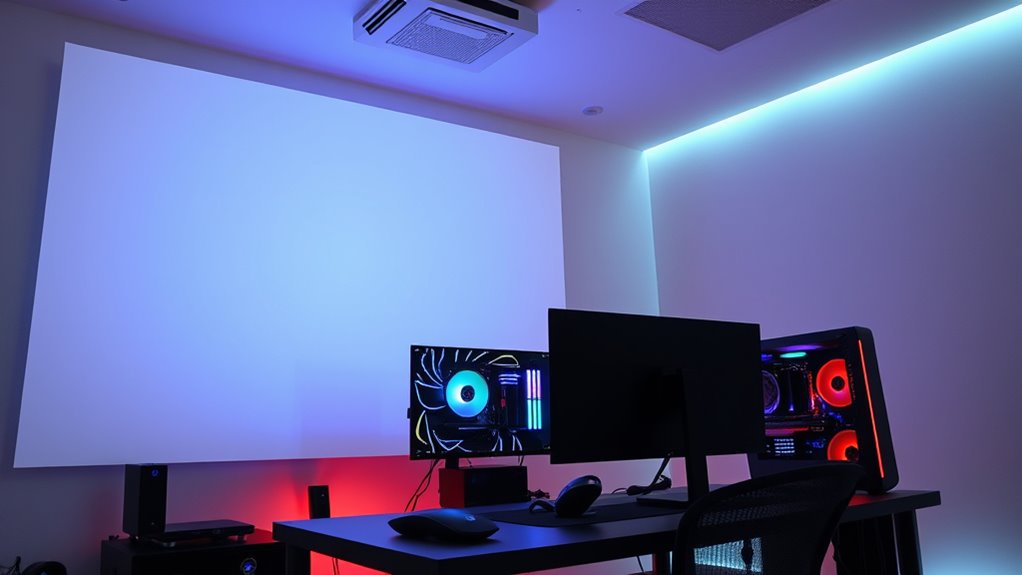
Playing PC games on a projector can transform your gaming experience by immersing you in a larger-than-life display. To get the most out of this setup, paying attention to image calibration is essential. Start by adjusting your projector’s settings to optimize clarity and color accuracy. Many projectors have dedicated menus for contrast, brightness, and color temperature. Fine-tune these options so that images look vibrant without washing out or appearing too dark. Proper image calibration not only enhances visual detail but also reduces eye strain during extended gaming sessions. If your projector supports keystone correction, use it to ensure the image is perfectly aligned and rectangular, preventing distortion that could hinder your immersion.
Adjust your projector’s settings for vibrant images and reduced eye strain during extended gaming sessions.
Sound optimization is equally important in creating a compelling gaming environment. Unlike a typical monitor, a projector usually doesn’t produce sound, so investing in a good sound system can elevate your experience. Connect external speakers or a soundbar to your PC to deliver clear, immersive audio. Position your speakers strategically around your gaming area to create a surround sound effect, making gameplay more engaging. Adjust volume levels and sound settings—such as bass and treble—to match your preferences and the game’s audio design. Some projectors include audio outputs; if yours does, use quality cables and configure the sound settings on your PC to ensure synchronized, high-quality audio.
Another key tip involves ensuring your PC’s graphics settings are optimized for the projector’s resolution and refresh rate. Set your game to run in a resolution that matches the projector’s native resolution for sharp visuals. Lowering the in-game graphics settings temporarily can also improve performance and reduce lag, especially if your PC isn’t high-end. Keep your graphics drivers up to date to prevent compatibility issues and ensure smooth gameplay. Additionally, choosing high-quality and vetted equipment can significantly enhance your overall setup and gaming experience.
Lastly, consider your ambient lighting. A dark room will maximize contrast and color vibrancy, making your gaming experience more immersive. Avoid bright lights or reflections on the screen that could distract or diminish image quality. With proper image calibration and sound optimization, you’ll create a seamless gaming environment that leverages the projector’s massive display to deliver an unforgettable experience. By carefully adjusting these settings, you’ll enjoy sharper visuals, richer audio, and a more engaging, cinematic adventure every time you hit ‘start.’
Frequently Asked Questions
Can I Use a Projector for 4K Gaming?
Yes, you can use a projector for 4K gaming, but make certain it has sufficient brightness, ideally 2,000 lumens or more, to handle ambient light. Check that it supports 4K resolution and offers low input lag for smooth gameplay. Also, consider sound quality, as built-in speakers may not suffice; using external speakers enhances your experience. Proper setup guarantees vibrant visuals and immersive audio for an ideal 4K gaming session.
What Is the Ideal Projector Throw Distance for Gaming?
The ideal projector throw distance for gaming depends on your projector’s throw ratio and screen size. Generally, you’ll want to maintain a suitable distance that ensures a clear, sharp image without distortion. For most setups, this means positioning your projector between 1.5 to 2.5 times the width of your screen. Check your projector’s specifications to find its projection throw and adjust accordingly for the best gaming experience.
How Do I Reduce Input Lag When Gaming on a Projector?
To decrease input lag when gaming on a projector, start by enabling low-latency or gaming modes in your projector settings. Use calibration techniques to optimize picture quality and guarantee minimal delay. Keep your firmware updated for the latest performance improvements. Also, synchronize audio properly to avoid lag discrepancies. Connecting your PC directly via HDMI and using a high-quality cable can further minimize input lag, giving you a smoother gaming experience.
Is a High Refresh Rate Necessary for Immersive Gaming?
A high refresh rate is essential for an immersive gaming experience because it ensures smoother motion and reduces motion blur. The refresh rate importance becomes even more apparent on a projector, where lag and stutter can break immersion. If your projector supports 120Hz or higher, enabling that setting helps you enjoy fluid gameplay, making your gaming sessions more engaging and responsive. So, prioritize a higher refresh rate for the best immersive experience.
Can I Connect Multiple Devices to a Projector for Gaming?
Yes, you can connect multiple devices to your projector for gaming. Use a multi-device setup with an HDMI switcher to easily toggle between your gaming console, PC, or streaming devices. This way, you avoid constantly unplugging and plugging in cables, ensuring smooth gameplay. Just make sure your projector has enough HDMI ports or connect an HDMI switcher for a seamless experience and quick access to all your devices.
Conclusion
Now, imagine the thrill of your game bursting to life on that massive screen, every detail sharp and vibrant. With the right setup, you’ll feel completely immersed, as if the action is happening right in front of you. But don’t stop here—tweak, experiment, and push your projector’s limits. The perfect gaming experience is within your reach, just waiting to be released. Are you ready to take your gaming to the next level?
